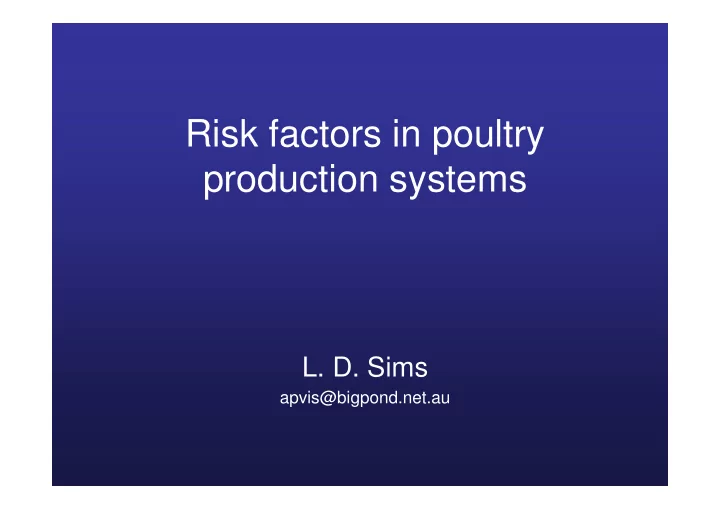

Risk factors in poultry production systems L. D. Sims apvis@bigpond.net.au
Risk of incursion • The risk of incursion of H5N1 HPAI viruses (or other pathogens) into a farm is determined by: - the number of ‘contacts’/links with the world outside the farm - the probability of each of these ‘contacts’ involving infected or contaminated material
Risk of virus incursion • This depends on the level of infection in the area (hard to measure and varies over time) … • And the measures taken to reduce the likelihood of infection on/in items that enter the farm (e.g. water treatment , change of clothes, etc)
Risk of virus incursion • Each individual farm or flock has its own risk profile for introduction of pathogens and subsequent development of disease • This is influenced by a number of factors, including the density of farms (density- dependent (airborne) and density-independent pathogens)
Biosecurity • “All measures taken to prevent incursion and spread of disease/pathogens” • “Biosecurity means taking steps to ensure good hygiene practices are in place so that the risk of a disease occurring or spreading is minimized” Defra UK
Farm biosecurity measures • Location • Physical • Operational • Disease can occur as a result of inattention to any of these
��������������������������� • Industrial integrated system with high level biosecurity and birds/products marketed commercially (low risk, high impact)
Poultry production system 1 • Highly sophisticated biosecurity measures • Often international linkages (operating in more than one country) • Strong political connections (trust) • High level of inputs and outputs • Prepared to relocate to more isolated sites • High impact if outbreak occurs
��������������������������� • Commercial non-integrated poultry production system; ‘moderate to high biosecurity’; birds and products marketed commercially
��������������������������� • Commercial poultry production system; minimum or very low biosecurity; marketing via live bird markets
Poultry production system 3 • Minimal investment in biosecurity measures • Sometimes due to lack of capital or lack of ownership of facilities • Some develop from smaller flock • Opportunistic • Often linked to live poultry markets • Some production methods cannot be made biosecure without totally changing the method of production (e.g. grazing ducks)
��������������������������� • Village or back yard production (scavenging) - no biosecurity, informal marketing
Poultry production system 4 • In some places limited links to formal market chain and in isolated communities very low risk (unless wild birds involved) • Attempts to fence scavenging poultry make no sense to poultry owners
What has H5N1 HPAI taught us? • Classifying all industrialised poultry farms together, without regard to the biosecurity measures implemented is unhelpful (provides no indication of the likelihood of disease outbreaks on individual farms) • This simplistic approach has been adopted by many of those critical of ‘intensive production” and its purported role in H5N1 HPAI
What has H5N1 HPAI taught us? • Most reports of H5N1 HPAI outbreaks in intensively reared poultry in Asia provide insufficient detail on the biosecurity measures practiced to assess whether disease occurred as a result of poor management or the level of infection around the farm overwhelmed otherwise ‘reasonable’ measures
What has H5N1 HPAI taught us? • In some situations, on-farm biosecurity measures alone are not enough to prevent infection and disease (e.g. Hong Kong) – combination of improved biosecurity with vaccination • Outbreaks may depend on a series of low probability events
What has H5N1 HPAI taught us? • ‘Blame’ for Asian-lineage H5N1 HPAI outbreaks cannot be attributed to any one production system (but note role of domestic ducks and poorly regulated live poultry markets) • Farms in all systems have been affected and played some role in the persistence and spread of this disease • Although more cases of HPAI are generally found in system 3 flocks there is insufficient accurate data to allow comparisons of susceptibility of different farm types (denominator data and ascertainment bias) •
Risk analysis • Done informally in establishing biosecurity measures • Should be done more often for farms • Will highlight large gaps in knowledge regarding the level of hazard to farms • Should follow standard steps • Qualitative, but can still measure certain aspects especially the effects of interventions
Biocontainment • Most farmers focus on preventing entry of pathogens and less about preventing onward spread • Major issue in areas with high poultry farm density • Role for government in regulation and enforcement
Enhancing farm biosecurity • Market forces (& self interest) • Regulation (and cost sharing for emergency disease) • Communication/persuasion (get message right) • Threat of litigation? (not yet but look at food safety in the US after E.coli O157) • Like buying insurance
The future • Loss of public tolerance for control through mass culling • Pressure on areas with high concentrations of farms • Pressure on system 3 (more contract growing?)
The future • Greater enforcement/regulation • Use of complementary measures if needed for ‘high risk’ production systems rather than their elimination
? ?
Recommend
More recommend